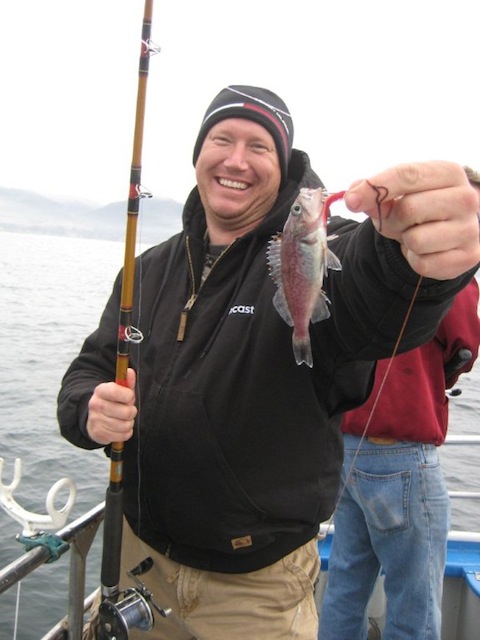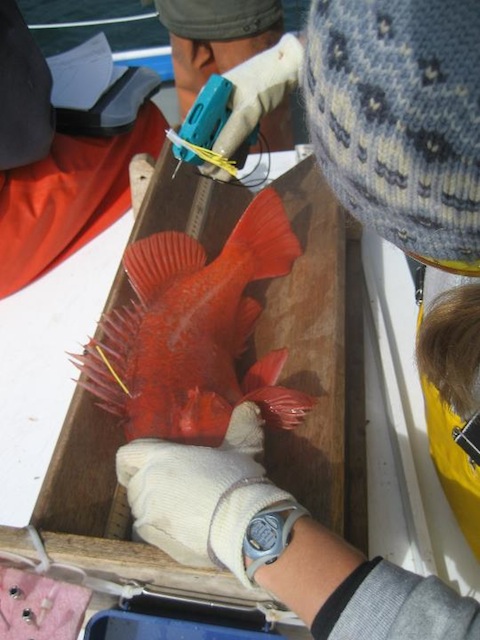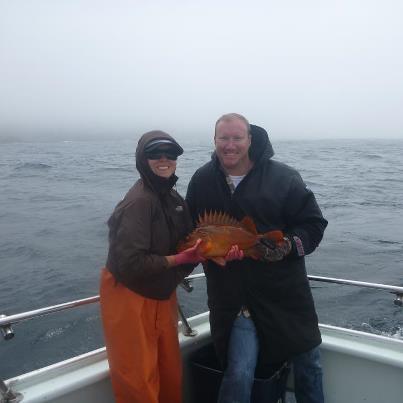 By Jeff Christensen, CSU Stanislaus
By Jeff Christensen, CSU Stanislaus
In 2011, I had the opportunity to participate in a California Collaborative Fisheries Research Program (CCFRP) fishing trip. When I received a message from Andrea Launer, CCFRP Volunteer Coordinator, this spring about the summer data collection schedule, I knew I wanted to go out again and be part of this amazing project.
With one of my classes starting on the first day of sampling, I wasn’t able to make the Monday, August 6th date but I was aboard F/V Caroline at Monterey’s Fisherman’s Wharf before sunrise on Tuesday with hot coffee in hand ready to do some angling. After a safety briefing by Captain Shorty we headed out along the Monterey coastline as Cannery row began to stir in the light of the pre-dawn sky. The sea was a bit rough and the wind waves made the trip out to the Point Lobos State Reserve a small adventure in and of itself.
Cheryl Barnes, CCFRP Field Coordinator and MLML graduate student, gave the anglers an amusing briefing about the specifics of the collection protocols of the catch and release program. In order for this work to be helpful in determining if the Marine Protected Areas (MPA) are effective in propagating the species within these areas since their inception in 2007, a variety of anglers were assigned different lures and/ or bait similar to fishing techniques used on guided recreational fishing trips from the area.
By the time Captain Shorty announced over the loud speaker to drop our lines in the water of the first research cell of the day, the rolling waves were already taking its toll on our balance and stomachs. The port side “fish feeding station” was busy early on but as the fog receded, we all got our sea legs and the fishing improved. The boat as a whole ended up catching and releasing a total of 176 fish from 14 different species, including a 84cm lingcod (Ophiodon elongates) caught by Chris L., fishing next to me. We must have been in some big fish because not too long after Chris’s lingcod, I hooked another giant fish, I estimated at over 100 cm (due to how hard it was to pull up) but after a perilous fight, the “Big One” got away as it neared the surface.

While the anglers were pulling up their catch, the scientific staff was busy collecting the fish, measuring them, tagging some, and making sure they were returned to the bottom as soon as possible. I was thoroughly impressed how each staff member tried to make sure every fish was returned to their home with human stories to tell of their own. One sea lion, however, was happy to accept a free lingcod h’ordurve as it took a large bite out of an angler’s catch as it was reeled up. That lingcod, too, was returned to the ocean making a meal for the fish, crab, and sea stars that would finish the work of the sea lion. The seas were rough as we headed back in and even tossed a few of us out of our seats to the deck (Ouch!).
Wednesday morning, I was hopeful it would be calmer than previous day at sea as we watched the harbor seals from the back of the Caroline conduct a morning ballet in the calm water around the docks before we headed out. That, however, would be the last calm water of the day. As we left the shelter of the harbor and made our way to the Point Lobos Reserve south of Carmel, I felt we should rename our sturdy vessel the S.S. Minnow.
The NW swell coming in combined with the gusty winds was going to make this trip an adventure. We were supposed to be sampling the reference cells outside of the Point Lobos Marine Reserve. As we arrived at the coordinates on the GPS, our hopes that the rough seas would subside were crushed. By the time we ended our first timed fishing sample, it was readily apparent that anglers were holding onto the railing of the boat to keep from losing their balance more than they were fishing. The CCFRP staff and Captain Shorty made the determination that the seas were just too rough for accurate data collection and the one fish that was caught during that session was the proof. I could tell that many anglers were disappointed in the weather but glad that someone else had made the call to head back into port.
The day wasn’t completely a waste, however. I still was able to see lots of rockfish, otters, sharks, jellies, and a wide array of other sea life as I headed to the Monterey Bay Aquarium and spent the day under the surface instead of riding the rough waves on top of it.
Thursday was another story. We still had a small swell rocking the F/V Caroline but that day was the best of the week so far. The foggy shoreline provided a nice cool morning of fishing that produced 136 fish from 9 anglers including some gorgeous Vermillion Rockfish (Sebastes miniatus) and Copper Rockfish (Sebastes caurinus). I even had a double catch of two young lingcod (Ophiodon elongates) on one line.


As we headed back into port, I felt like it was a good day of fishing. The sea gulls following our boat, waiting for a fishy buffet must have had different thoughts though. They must have been wondering where all the fish we had caught had gone to because there were no deckhands at the fish cleaning stations hurling them their meals. “No fish for you today, Mr. Seagull. Today we are making sure there are enough fish for you tomorrow.”
I can’t say I blame the seagulls for being disappointed. As we headed back to Fisherman’s Wharf, I felt a sense wanting a couple of fish for the dinner table this week as well. I myself enjoy fishing and have a greater sense of satisfaction knowing the fish I eat come from a healthy population and ecosystem. In the conversations I had with the other anglers on the boat, I got the feeling they share the same sense of balance that comes from promoting healthy ecosystem that I have. I enjoyed the pleasure of the “hunt” with the catch-and-release protocols and know that the fishing we were doing would serve a greater purpose in bringing some of that balance back to the sea. I know that had I seen that huge Copper Rockfish underwater while spearfishing, I would have tipped my hat to it as it swam by just because of its’ rare beauty and age. But I can’t help looking at the picture of Andrea and I holding that Copper and saying, “Nice fish.” I just hope there are more of those big old fish around to spawn and send out young fish out into the ocean for everyone to enjoy, both to look at and to eat.

